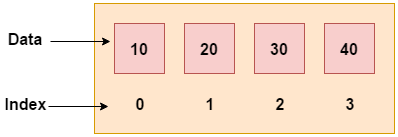Hi everyone, inside this article we will see about C++ Arrays.
In C++, an array is a collection of elements of the same data type, stored in contiguous memory locations. Arrays are used to store and manipulate a collection of data values that can be accessed using an index or subscript.
They can be used to store a collection of any type of primitive data type, including int, float, double, char, etc. An array in C/C++ can also store derived data types like structures, pointers, and other data types, which is an addition.

Advantages of C++ Array
There are several advantages of using C++ arrays:
Efficient memory usage: Arrays store data in contiguous memory locations, which makes them efficient in terms of memory usage and access times.
Random access: Elements in an array can be accessed randomly using an index or a subscript. This allows for fast and efficient data retrieval and manipulation.
Flexibility: C++ arrays can store elements of any data type, including primitive data types, objects, and pointers. This makes them flexible and versatile in a variety of programming tasks.
Performance: C++ arrays offer high performance for many applications, especially those that require large data sets and fast data access and manipulation.
Portability: C++ arrays are a core feature of the C++ language and are supported by all major compilers and platforms. This makes them highly portable and easy to use across different environments.
Easy to learn and use: C++ arrays are a basic data structure in the C++ language and are easy to learn and use. They provide a simple and efficient way to store and manipulate data in a program.
Overall, C++ arrays provide an efficient and flexible way to store and manipulate data in a program, making them a powerful tool for a wide range of programming tasks.
Disadvantages of C++ Array
There are several disadvantages of using C++ arrays:
Fixed size: Arrays have a fixed size, which means that once an array is declared, its size cannot be changed. This can be a limitation in applications where the size of the data set is not known in advance.
Memory management: C++ arrays do not provide automatic memory management, which means that the programmer is responsible for allocating and deallocating memory for the array. This can be error-prone and can lead to memory leaks or segmentation faults.
No bounds checking: C++ arrays do not perform bounds checking, which means that the programmer must ensure that the index or subscript used to access an element is within the bounds of the array. If an index is out of bounds, it can result in undefined behavior or a runtime error.
Inflexibility: Arrays are inflexible in terms of data manipulation. For example, inserting or deleting elements from an array requires shifting all the elements after the insertion or deletion point, which can be inefficient and time-consuming for large arrays.
Pass by reference: When passing an array to a function, it is typically passed by reference, which can lead to unintended side effects if the function modifies the contents of the array.
Overall, while C++ arrays are a useful data structure in many applications, they can be limiting in terms of flexibility, memory management, and bounds checking. In some cases, other data structures, such as dynamic arrays, linked lists, or hash tables, may be more appropriate.
Types of Arrays
- Single Dimensional Array
- Multidimensional Array
Why do we need C++ Arrays?
C++ arrays are a fundamental data structure that allow programmers to store and manipulate collections of data in a program. They are an essential tool in many programming tasks, and provide several important benefits, including:
- Efficient memory usage
- Random access
- Flexibility
- Performance
- Portability
- Easy to learn and use
Overall, C++ arrays are a powerful tool for storing and manipulating collections of data in a program. They are essential in many programming tasks, and provide a simple and efficient way to work with data in a program.
Important Things to Remember while Using Arrays in C++
When using arrays in C++, there are several important things to keep in mind to ensure that the program works correctly and efficiently. Some of these key considerations include:
Array size: The size of an array must be specified when it is declared, and cannot be changed during program execution. It is important to ensure that the array is large enough to hold all the data it needs to store, but not so large that it wastes memory.
Array indexing: Array elements are accessed using an index or subscript, which must be within the bounds of the array. It is important to ensure that the index used to access an element is within the array bounds to avoid undefined behavior or a runtime error.
Memory allocation: Arrays in C++ are allocated on the stack or heap, depending on how they are declared. It is important to understand how memory allocation works and to ensure that the array is allocated and deallocated correctly to avoid memory leaks or segmentation faults.
Array initialization: Arrays in C++ can be initialized with values at the time of declaration. It is important to ensure that the initialization values are provided in the correct order and that the array is not accessed before it is initialized.
Array copying: When copying an array in C++, it is important to use a safe and efficient method, such as the standard library function std::copy(). It is also important to ensure that the destination array is large enough to hold all the elements from the source array.
Multidimensional arrays: When working with multidimensional arrays in C++, it is important to understand how the elements are stored in memory, and to use the correct indexing scheme to access the elements.
Overall, when using arrays in C++, it is important to pay attention to the array size, indexing, memory allocation, initialization, copying, and multidimensional array access. By keeping these key considerations in mind, programmers can ensure that their programs work correctly and efficiently when using arrays.
We hope this article helped you to understand about C++ Arrays in a very detailed way.
Online Web Tutor invites you to try Skillshike! Learn CakePHP, Laravel, CodeIgniter, Node Js, MySQL, Authentication, RESTful Web Services, etc into a depth level. Master the Coding Skills to Become an Expert in PHP Web Development. So, Search your favourite course and enroll now.
If you liked this article, then please subscribe to our YouTube Channel for PHP & it’s framework, WordPress, Node Js video tutorials. You can also find us on Twitter and Facebook.
